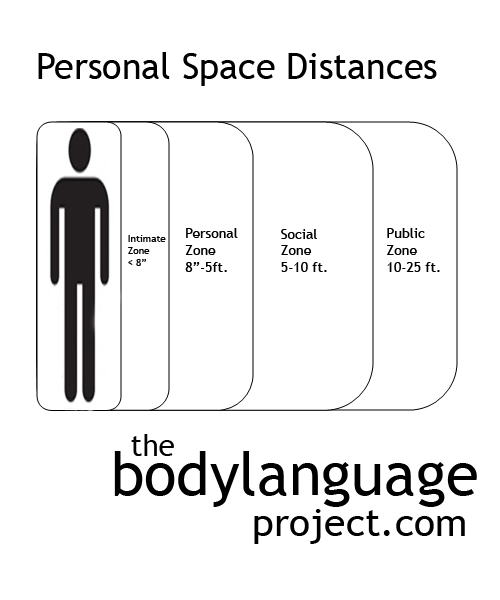Body language is a fundamental part of courtship. As we have learned, verbal language is risky and not only because it may lead to embarrassment, but because it often requires a verbal response from others, which can turn out to be tragically embarrassing. Keeping spoken words out of courtship initiation process and therefore out of consciousness will save us plenty of grief from being openly rejected, or perhaps even worse, negative feelings with having to reject. Using and reading nonverbal cues therefore is important in courtship, so pay particular attention to the following signals so you can judge interest yourself, without saying a word. Courtship signals are extensive and complex, perhaps numbering in the thousands, so I will only cover the basics here. For those that want more detail, they may wish to read my e-book Body Language Project: Dating, Attraction and Sexual Body Language (2007). Much more emphasis is placed on instruction for men to help them read women better, although it can be helpful to women who wish to send more appropriate signals of attraction, rejection or to simply bring from the subconscious the signals they use all the time.
Tag Archive for Sexual Partners
The Types Of Hugs
by Chris Site Author • March 6, 2013 • 6 Comments

An intimate hug is obvious by checking the distance between the hips. The smaller the distance, the more intimacy is present. When we hug grandma, we might only touch shoulders by leaning in!
There are two types of hugs and each one indicates a different level of intimacy. The first is called the “full body hug” and is reserved for sexual partners. This type of hug is characterized by full chest to chest and hip to hip contact. Since the bodies are so tightly pressed together, the genitals might also touch incidentally. The second type of huge is the “light social hug”, the main hug for acquaintances and friends, and happens when the shoulders come together as the torso hunches forward, but the hips remain apart.
Hugs have a secondary hidden meaning as well. The longer the hug, the more intimate and affectionate is the relationship. A pat at the end of the hug indicates that one party would like to “submit” from the hug and terminate it. This gesture is similar to the actions wrestlers to do “tap out.” Taps also show feigned or meaningless hugs, or even unwelcome hugs, especially if the tap happens early. Most people think tapping while hugging shows comfort, but sexually romantic partners and close family members do not pat, they embrace deeply and squeeze tight.
The hips, during a hug, also have a very significant hidden meaning. That meaning is conveyed directly through the distance to which they remain separated and that distance tells us a lot about the type of relationship two people have. Hugs that happen between family and friends will have at least six inches between the pelvic regions of each person, whereas hugs from lovers have no, or very little space between the hips. The torsos of lovers also move tightly into each other’s intimate zones enveloping each other. The degree to which hips remain separate, or rear-ends are extended outward, whichever you prefer, and the amount of contact that takes place in the upper chest, tells us what degree of intimacy is present between huggers. Light hugs as we saw, can include only light shoulder contact, and in extreme light hugging, the bodies might not press together at all. The arms and hands might form a closed loop from shoulder to shoulder “around” them, but the chest and shoulders might only seem to move slightly closer, or seem to bob in quickly before moving out, not coming any closer than a foot. The hidden language of hugs can tell us a lot about the relationships around us, even potentially juicy ones like those brewing amongst staff members. A careful eye at the next social affair might uncover some cheeky relationships!
Tonality And Voice Depth
by Chris Site Author • March 5, 2013 • 0 Comments
The differences between the sexes is huge when it comes to our voices. Women’s voices are nearly twice as high pitched as men’s so with only rare exceptions, we all know which sex is speaking even without seeing them. The term “pitch” is defined as the voices “highness” or “lowness” of the voice which is affected by the natural body chemical androgen. Androgen is the male sex hormone which is also tied to physical prowess and aggressiveness and also loosely tied to a competitor’s health and vigor.
In 2005 Anthropologist David Puts used voice recordings of men to study the relationship between the tone of the voice and men’s attractiveness. He was able to increase and decrease the pitch of the voices using computer software to make the recording more or less dominant. Puts found that low-pitched masculine voices increased ratings of men’s physical and social dominance. He also found that men who felt they were more dominant than their competitors tended to lower their voices when speaking with them. Additionally, men who had deeper voices also reported having had more sexual partners over the year previous to the study. Naturally, women have also been shown to prefer men with lower pitched voices for short-term sexual relationships. Voice pitch can also help men rise in social dominance. For men, this means plenty. It means that lowering the voice can lead to a better attractiveness rating in the eye of women and can also be used as a tool to build dominance and leadership.
The pitch of the human voice also varies with emotional state. Even actors are able to portray different feelings based on their voice. You can imagine a father with his baby where he draws out his voice and makes it more like mom so he can grab his infants attention. Women can also lower their voices to be more like dad to scorn their children or conversely screech at them when they are really upset. The tendency to raise the pitch of the voice at the end of each sentence to make all statements seem like questions, is a bad habit adopted frequently by young women. If carried into adulthood, it can be disastrous in a business context. People read this inflection as a signal of insecurity and believe that you are unsure about what you are saying. In a business context, it is always best to be direct and act with conviction.
Status, Context And Personal Space
by Chris Site Author • March 5, 2013 • 0 Comments
Status and context affect spatial and proximity rules. For example, bosses are in charge of determining what level of closeness is appropriate and permitted as it relates to subordinate employees. This isn’t to say that employees enjoy this arrangement but rather that employees are not permitted to reverse proximity rules onto employers. Subordinate employees have many roles and one of them is tolerance of the rules set for them by their seniors. For example, a boss might pat the back of one his employees or put his or her arm around the new associate as a form of bonding. Reversal of the situation would be seen as an infringement on the status of the boss. When it comes to touching, a subordinate should never encroach on the personal space of someone holding a dominant position.
Contextual rules also exist with respect to personal space. In the office, it would be un-acceptable for sexual partners to touch one another or carry on in front of others. However, in the same office hosting a year-end business party with all of the same employees and their spouse’s, touching and even kissing would be common place.
Therefore, status and context are two other factors we should be conscious of as they relate to proximity and space.
Personal Space Distances
by Chris Site Author • March 5, 2013 • 0 Comments
There are four distances by which people interact. They are the “intimate distance” where only about eight inches or less separates two people, the “personal distance” from eighteen inches to five feet, the “social distance” which is from five to ten feet and the “public distance” which is from ten feet to twenty-five feet. We tolerate intimate distances for embracing, touching, or whispering from sexual partners, family members and occasionally, even friends. Personal space is reserved for good friends and those we have a fairly high level of trust. The social distance is reserved for acquaintances that we perhaps don’t fully trust yet, but otherwise need to interact with, and the public distance is that which we use to address large audiences.

An arm is extended to indicate that personal space is being violated and protect a personal space bubble.
Our personal space, the area next to our bodies, which we protect against intrusion, has been referred to as a “bubble”, since it encircles us, but it more closely resembles a cylinder. The cylinder encompasses our entire bodies, from our feet to our head. It is this cylinder that we protect rigorously, and when it is violated we tense up or back away so as to reduce or prevent additional overlap from the cylinders of others. Our personal space isn’t totally fixed either. It is constantly expanding and contracting depending on our environment and company. For example, we permit children, pets, and inanimate objects into our personal space regularly because we do not perceive them as a threat, but other adults must earn our trust before entering. Our personal space tolerances are directly related to the strength of our relationship.
In basic terms, our personal space zone is the perimeter that we feel is suitable to act as a buffer should a dangerous situation arise. It provides us with enough time and space, we think, to react and mount a defensive posture to protect ourselves from an attack. In a busy public area, we might tolerate (although not prefer) moderate contact due to space limitations, but when space is abundant we see even mild intrusions as a predictors of an attack. Our personal space zone, therefore, is an early warning system that we use to help us predict the intensions of others.
These zones and distances are not immutable and universal, but are meant as a guide or rule of thumb. Everyone has different levels of comfort based upon their upbringing, personality type, gender, age and so forth. The summary listed below is a guideline that is meant for those living in areas such as Australia, Canada, United States, Great Britain and New Zealand or other westernized countries such as Iceland and Singapore or Guam. For other countries not listed, the zones may expand or contract based on the inverse of their density. For example, Japan and China which have a high density have smaller intimate zone distances. There is an inverse correlation to each zone, where the greater the population density, the tighter the zones.
The safest way to test a person’s need for personal space is to move close, lean in, give a hearty but not overly aggressive handshake, then take a step back to allow the person to either move in closer to shrink the space between you and them or take a step backward, to suite a larger than average personal space requirements. Too often people will move in too tight and overshadow someone else only to make them uncomfortable. If someone requires less space, they won’t feel offended to take up the space between you, and if you care anything about them, you won’t feel a need to step backwards either. Shrinking space is a way for people to tell you that they enjoy you, and your company, and one that you should not take offense to, but rather use as a measure of someone’s level of comfort.
1. Intimate zone – eight inches and less. This is our intimate space which we protect vigorously. We permit only those we trust emotionally to enter including parents, children, friends, lovers, relatives and pets. Lovers (and pets) are the only ones we permit to enter for any length of time, the rest we allow entry for only short instances such as for hugs.
2. Personal zone – eight inches to five feet. This is the distance from which we communicate to acquaintances; those we have achieved some level of trust. Examples include bosses and fellow employees, friends of friends, and so forth.
3. Social zone – five feet to ten feet. Normal for people on a first encounter such as people on the street asking for directions, a clerk at a store, strangers at a supermarket and other people we don’t know very well. Here we struggle between conflicting needs, one is to maintain enough space for comfort and the other is to be close enough to communicate effectively.
4. Public zone – ten feet to twenty-five feet. This is the zone at which it is comfortable to address a large group of people or audience during a presentation or speech. Even if we know all the members of the group well, we still maintain a greater distance from them so we can easily address all of them and keep everyone in our field of view. This could be an evolutionary adaptation since a large group could easily contain rogue defectors. By getting too close to an audience we risk surprise attack which is why we feel more comfortable with a wider buffer. Then again, it could simply be a function of judging the efficacy of our speech by measuring the audience’s reaction.




